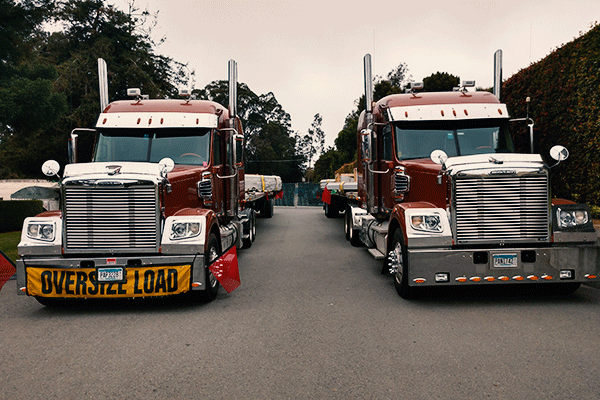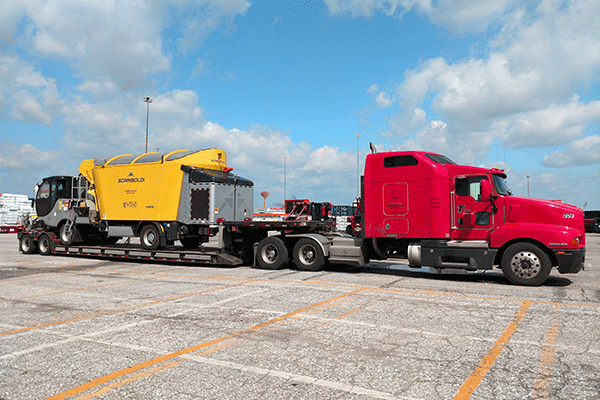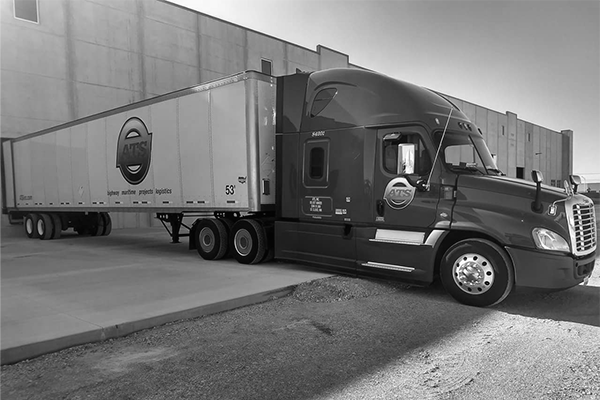
As one of your company’s core decision-makers, you’re constantly looking for ways to improve. The business world is competitive and there are companies in your industry that are excellent at what they do. But you’ve never been one to back down from a challenge.
Just like anyone else in your position, you’ve seen your fair share of successes and failures. The highs further your progress toward lofty goals. The lows only serve to motivate you further.
That said, continual improvement takes sacrifice, dedication and an appetite for learning — a fact you know all too well. As such, you’re here to explore a shift that many of your competitors are making; a shift that’ll increase the value your company brings to the marketplace.
You’re here for information on how to successfully route your freight — a process that can be highly beneficial to both your business and your customers' when handled correctly.
Here at ATS, we’ve seen plenty of businesses make this transition. Some did so with great success and saw their market share increase to match improved customer satisfaction.
Others, though, didn’t have such great results.
Life is all about learning from your mistakes and the mistakes of others. And, over the years, we’ve observed a pattern emerge between those who route their freight successfully and those who don’t.
Although exact tactics vary from business to business, by following the steps below, you’ll likely succeed in this process, increasing your customer base, satisfaction and loyalty for years to come.
Let’s get into it.
The four most important steps to routing your own freight are:
- Understand and weigh the pros and cons.
- Select an individual to fully own this process.
- Find and vet great transportation providers.
- Continuously re-evaluate and optimize your processes.
Step 1: Understand and Weigh the Pros and Cons
Simply put, routing freight isn’t right for every company.
Before anything else, it’s important that you firmly understand your company’s capabilities, how you hope to benefit from routing freight and what the potential downsides of doing so are.
Without acknowledging these things and developing a firm plan of action with them in mind, many companies fail to get this right. That said, if you send three to five shipments a week and expect to continue to grow in the future, routing your freight is worth considering.
Will routing freight be the easiest thing you’ve done? No. But it doesn’t need to be the hardest either.
Let’s talk about the pros and cons of routing your freight, beginning with the potential downsides.
The 3 Main Disadvantages of Routing Your Freight
1. Routing Freight Requires Oversight
You won’t be able to come through for your customers consistently without dedicating a significant portion of time to overseeing the logistics of freight movement.
For many businesses, making this investment is just too difficult with everything else on their plate. As such, routing freight for companies that can’t put in the effort won’t be feasible.
2. Routing Freight Takes Expertise
There’s a bit of a learning curve when it comes to the transportation world. This industry isn’t exactly easy on newcomers. With so many moving pieces and intricacies, it’s not uncommon for businesses — that are just beginning to move their freight — to feel overwhelmed.
Don’t worry. If you’re just getting started, you can find a great transportation provider to help you get this right (skip to step three).
3. Routing Your Shipments Will Take Resources
The final disadvantage you’ll want to be aware of — while still in the consideration phase — is the fact that deciding to route your freight isn’t as simple as purchasing new transportation software, setting it to autopilot, and forgetting about it.
No, to do this properly, you’ll need to select a point person, train them properly and invest in their success. As such, the up-front time and money that routing your freight will demand might deter you from starting.

The 4 Main Advantages of Routing Your Freight
1. Routing Your Freight Can Make You Money
For your customers, who don’t necessarily have the expertise needed to cost-effectively route their shipments, removing this burden from their plate will be a welcome convenience. And, as you begin to understand the transportation world and your providers begin to understand you, cutting down your freight costs will get easier — leaving more money in your pocket after each transaction.
Always remember: Happy customers = repeat customers. The easier it is to work with your business, the more likely it becomes that they’ll come back next time a need arises.
2. Routing Freight Increases Your Control
As a flourishing business, you understand the value of controlling what you can. That said, letting customers route their goods makes it difficult to manage your loading areas.
Trucks that show up at the same time is harmful to multiple supply chains and communicating with carriers through your consignees can become a not-so-fun game of telephone.
Mitigate challenges, and issues, like these by managing your supply chain with providers you trust.
3. Routing Your Freight Adds Value For Your Customers
Just like you, your customers have a lot on their plates. Anything you can do to make their lives easier will solidify your place in their good graces. Routing their purchases directly to their front door without requiring them to lift a finger will add a huge amount of value to your relationship.
No supplier ever went broke because of repeat business, and routing your customer’s products has the potential to bring plenty of it to your shores.
4. Routing Your Shipments is Good For Your Reputation
If your customer’s freight doesn’t show up on time, causing them delays, they won’t remember the name of the trucker on their failed load or the time they spent finding a solution. No, they’ll remember who they purchased the product from and how difficult it was to get it in a timely fashion.
You’ll want to get ahead of these potential issues. Routing your freight is the best way to promote its successful transit. By doing so, you get to vet and select the carriers used, you get to coordinate the appropriate pick-up time and you get to wear the stamp of heroism in your customer’s mind.
Related: The Pros and Cons of Routing Your Own Freight
Step 2: Select an Individual to Fully Own This Process
After you’ve weighed the pros and cons of managing your freight movement against your capabilities, step two is easy enough — find someone to oversee this process.
Having a figurehead in place whose sole duty is to manage the logistics of routing freight for customers is hugely important. Not only will this person be charged with scheduling the comings and goings of trucks, but a couple of other things as well.
Some additional duties of your logistics manager will be:
- Finding potential transportation providers.
- Vetting potential transportation providers.
- Coordinating with providers and consignees to arrange picks and deliveries.
- Organizing and arranging all paperwork.
- Record, monitor and evaluate providers on various KPIs:
- On-time arrival rates
- On-time delivery rates
- Tender acceptance rates
Finding the right person for this role — a person that’s open to learning and intimately understands your business — might be easier than you’d think. In fact, you probably already have them working for you in another capacity.
Often, businesses that transition to routing their freight find it easiest to find a logistics manager from within. This individual already knows your business and values the work you’re doing. Knowing they’ve done good work for you in the past will make having them pivot their responsibilities and handing them the reigns all the easier.
No matter who it is, or where you find them, having a single person managing your freight movement is a key piece of this process.

Step 3: Select Your Transportation Providers
Once you’ve decided that routing freight is the right option for your business and have selected a person to oversee this change, your next step is the most crucial; start building a network of transportation providers.
When it comes to building a solid network of reliable transportation providers you’ll find that doing so can sometimes be easier said than done.
You see, the transportation industry is huge. With low barriers to entry, trucking companies and freight brokerages pop into and out of the marketplace all the time.
This can make selecting a stable provider difficult and developing rapport with your providers over time challenging. To transport your freight, you’ll want to cash in on one of the benefits of doing so and only use the best providers possible.
But how will you know you can trust their reliability? How can you ensure that they value safety and quality partnerships to the same extent you do?
Picking the right providers can be difficult, especially with so much at stake. But it doesn’t have to be. Use these free tools to help you create a healthy transportation network:
When selecting a freight brokerage, use:
- The Freight Brokerage Selection Common Mistakes Guide
- The Freight Brokerage Selections Checklist
- 6 Ways to Identify an Ideal Freight Broker
When selecting an asset carrier (trucking company), use:
- 6 Key Factors For Choosing The Right Carrier
- 7 Signs to Know if You’re Hiring a Stable Transportation Provider
To evaluate the performance of each company, including how reliable they are and how accurate their pricing is, you’ll want to have a good mix of provider types.
Pick some freight brokerages and some asset carriers, weigh them against each other and only work with the best of them.
Step 4: Continuous Re-Evaluation and Optimization
Good business is all about striving to be better; never settling for second best when first is within reach. You should treat your freight-routing processes the same way.
There’s always some way you can improve, some wasted seconds you can get back, a few extra dollars you can save next time. If you want to reap all the benefits routing your freight has to offer — including the potential to make money — continuous evaluation is key.
When we say “continuous evaluation” we mean a few of things:
- Periodically, as it makes sense, think about ways to expedite your loading times (this will help you avoid extra fees and delays).
- Can you stage products? Is it feasible to bring on extra help during peak seasons? Would a different system help coordinate trucks?
- Regularly test current providers against each other on tangible and intangible transportation KPIs.
- On-time performance
- On-time arrival rates
- On-time departure rates
- On-time delivery rates
- Tender acceptance rates
- Tender rejections rates
- Invoice accuracy rates
- Communication
- Safety scores
- Ask yourself the tough questions:
- Do my current providers handle multiple needs?
- Are there other modes or providers that can support a changing or thriving supply chain footprint?
The first step toward a quality supply chain is a willingness to put in the effort.
Continuously working to optimize your procedures, alleviate communication issues and offer the highest service level possible will help you master the art of routing your freight.

We’re Here to Help
At the end of the day, we only want you to do what’s best for your business. If routing your freight is it, great. If not, that’s great too. You know your business better than anyone else and if you’re not ready to make this leap then don’t. Plain and simple.
That said, managing the freight movement process isn't nearly as difficult as many shippers making it out to be.
The lost revenue associated with not adding this capability to your supply chain multiplies over time. Sure, the initial stages of adopting this process can be difficult to manage. In the long run, though, you'll like the outcome.
If you have any questions about how to begin the process of routing your freight, please don’t hesitate to reach out. We’d be happy to help make this transition as smooth as possible.
Here at ATS, we take pride in helping this nation’s businesses get the most from their transportation supply chains.
To do this, our talented group of experts releases educational content to our Learning Hub multiple times each week. If you’d like to be notified of future articles, videos, downloadable tools or case studies created to help your business grow, subscribe to our list today.




